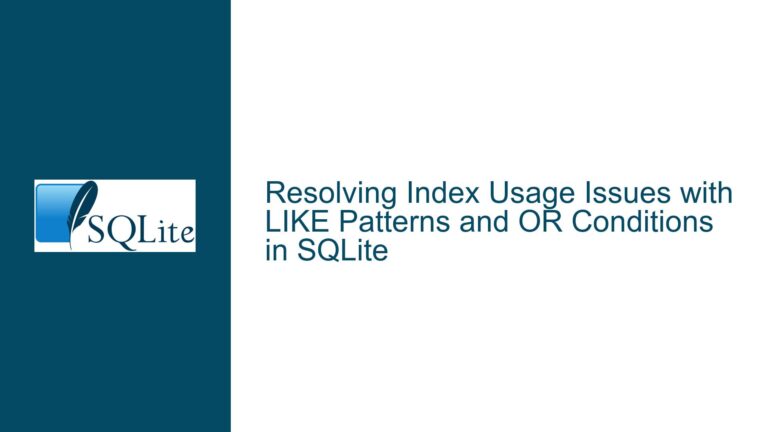SQLite Query Plan Optimization: IN vs OR Clause Performance Issue
Understanding the Query Plan Discrepancy Between IN and OR Clauses
The core issue revolves around the discrepancy in query plans generated by SQLite when using the IN operator versus the OR operator in a DELETE statement. Specifically, the query DELETE FROM edge WHERE :vertex IN (src, dst) results in a full table scan (SCAN edge), whereas the logically equivalent query DELETE FROM edge WHERE src = :vertex OR dst = :vertex leverages a multi-index search (MULTI-INDEX OR), which is significantly more efficient. This behavior highlights a critical optimization gap in SQLite’s query planner when handling the IN operator in certain contexts.
To fully grasp the implications of this issue, it is essential to understand the underlying mechanics of SQLite’s query planner, the role of indexes, and how different syntactic constructs influence the execution plan. The IN operator is often used as a shorthand for multiple OR conditions, but as demonstrated in this case, the two are not always treated equivalently by the query planner. This discrepancy can lead to suboptimal performance, especially in scenarios involving large datasets or complex queries.
The table edge in question has two columns, src and dst, both of which are defined as ANY [BLOB] NOT NULL. Additionally, the table has two unique composite indexes: one on (src, dst) and another on (dst, src). These indexes are designed to enforce uniqueness and improve query performance. However, the query planner’s inability to utilize these indexes effectively when the IN operator is used suggests a limitation in SQLite’s optimization capabilities.
Potential Causes of the Query Plan Discrepancy
The primary cause of this discrepancy lies in SQLite’s query planner and its handling of the IN operator. The query planner is responsible for determining the most efficient way to execute a given query, and it does so by evaluating various execution plans and selecting the one with the lowest estimated cost. In this case, the planner fails to recognize that the IN operator can be rewritten as an OR condition, which would allow it to utilize the available indexes.
One possible reason for this failure is that the IN operator is treated as a single atomic operation, rather than being decomposed into its constituent parts. When the query planner encounters :vertex IN (src, dst), it may not attempt to break this down into src = :vertex OR dst = :vertex, even though the two are logically equivalent. This lack of decomposition prevents the planner from considering the use of the indexes on src and dst.
Another factor contributing to this issue is the way SQLite handles type affinity and implicit type conversion. The ANY [BLOB] type used for the src and dst columns allows for a wide range of data types, which may complicate the query planner’s ability to optimize the query. The planner may be hesitant to use indexes in cases where type conversion is required, as this could lead to incorrect results or performance degradation.
Additionally, the query planner’s cost estimation model may not accurately reflect the benefits of using indexes in this particular scenario. The planner may underestimate the cost of a full table scan compared to a multi-index search, leading it to choose the less efficient execution plan. This could be due to a lack of statistical information about the distribution of values in the src and dst columns, or it could be a limitation of the cost model itself.
Resolving the Query Plan Discrepancy: Steps, Solutions, and Fixes
To address this issue, several approaches can be taken, ranging from manual query rewriting to more advanced techniques involving query planner hints and schema modifications. Each approach has its own advantages and trade-offs, and the best solution will depend on the specific requirements and constraints of the application.
Manual Query Rewriting: The simplest and most immediate solution is to manually rewrite the query to use the OR operator instead of the IN operator. This approach ensures that the query planner can utilize the available indexes, resulting in a more efficient execution plan. For example, the query DELETE FROM edge WHERE :vertex IN (src, dst) can be rewritten as DELETE FROM edge WHERE src = :vertex OR dst = :vertex. This manual rewrite is straightforward and does not require any changes to the schema or the query planner.
Query Planner Hints: Another approach is to use query planner hints to guide the planner toward a more efficient execution plan. SQLite provides several mechanisms for influencing the query planner, including the use of indexed columns in the WHERE clause and the INDEXED BY clause. By explicitly specifying the indexes to be used, it is possible to force the planner to consider the multi-index search strategy. For example, the query DELETE FROM edge WHERE src = :vertex OR dst = :vertex INDEXED BY sqlite_autoindex_edge_1, sqlite_autoindex_edge_2 would instruct the planner to use the specified indexes, potentially improving performance.
Schema Modifications: In some cases, modifying the schema to better align with the query patterns can lead to significant performance improvements. For example, if the src and dst columns frequently participate in IN or OR conditions, it may be beneficial to create additional indexes or to adjust the data types to reduce the complexity of type conversion. However, schema modifications should be approached with caution, as they can have far-reaching implications for the application and may require extensive testing and validation.
Query Planner Enhancements: The most comprehensive solution would involve enhancing the SQLite query planner to better handle the IN operator in cases where it can be decomposed into OR conditions. This would require modifications to the SQLite source code, specifically in the query planner logic. The enhancement would involve recognizing the equivalence between :vertex IN (src, dst) and src = :vertex OR dst = :vertex and generating the appropriate execution plan. This approach would provide a long-term solution to the issue, benefiting all applications that rely on SQLite.
Analyzing Query Plans: To diagnose and address query plan discrepancies, it is essential to analyze the query plans generated by SQLite. The EXPLAIN QUERY PLAN statement provides valuable insights into how the query planner intends to execute a given query. By comparing the query plans for different formulations of the same query, it is possible to identify inefficiencies and determine the best course of action. For example, in the case of the edge table, the query plan for DELETE FROM edge WHERE :vertex IN (src, dst) shows a full table scan, while the query plan for DELETE FROM edge WHERE src = :vertex OR dst = :vertex shows a multi-index search. This comparison clearly highlights the performance difference between the two approaches.
Benchmarking and Profiling: To evaluate the effectiveness of different solutions, it is important to conduct benchmarking and profiling. This involves executing the queries with different formulations and measuring the execution time, resource usage, and other performance metrics. By comparing the results, it is possible to determine which approach provides the best performance for the specific use case. Benchmarking should be conducted with realistic data sets and workloads to ensure that the results are representative of real-world conditions.
Community and Documentation: Finally, it is important to engage with the SQLite community and consult the official documentation for additional insights and best practices. The SQLite forum, mailing lists, and other community resources can provide valuable advice and support for addressing query optimization issues. The official documentation, including the section on the IN operator and query planning, offers detailed explanations and examples that can help clarify the behavior of the query planner and guide the development of effective solutions.
In conclusion, the discrepancy in query plans between the IN and OR operators in SQLite highlights a potential optimization gap in the query planner. By understanding the underlying causes and exploring various solutions, it is possible to address this issue and improve query performance. Whether through manual query rewriting, query planner hints, schema modifications, or enhancements to the query planner itself, there are multiple avenues for achieving more efficient execution plans. Careful analysis, benchmarking, and engagement with the SQLite community are essential for identifying and implementing the best solution for a given application.






